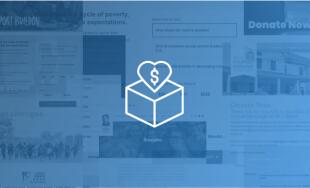10 ways to market your nonprofit online
Because nonprofits often have to work with a limited budget, online marketing provides a great opportunity to spread an organization's message without using too many resources. While many nonprofits understand that focusing more on online marketing can be valuable, they're not sure where to start. Here are 10 ways for nonprofits to promote their brand and upcoming events, as well as encourage donations.
1) Your nonprofit should have an attractive and dynamic website
An organization's website is the hub of its online presence. It presents a completely branded message of the organization's activities, its cause and its mission and as a result, much of the organization's other marketing activities will push users to the organization's website. Because of its importance, maintaining an attractive and dynamic website is a necessary first step to prepare the rest of an organization's online marketing for success. A beautiful nonprofit website design will give visitors an immediate positive first impression of the organization and a content managment system that easily allows for consistent updates will encourage visitors to come back frequently.
2) Share what your nonprofit and others in your industry are doing offline on the website and through social media
Nonprofits have the luxury of consistently doing positive things for the world that people genuinely enjoy reading about, and as a result, are more likely to spread. In addition to their websites, social media like Facebook, Twitter, Flickr and YouTube provide an ideal outlet for nonprofits to post their work and encourage readers to share it with their friends, family and co-workers.
For every one of your own events that you're promoting, try to comment on or share another organization's event or article. Not only will you learn more about what's going on in the industry, but those other organizations will be more likely to share your work in the future.
3) Let the people who care show that they care through testimonials and storytelling
Because nonprofits are more likely to have passionate supporters than many other organizations, it's important to let those supporters show their support. Either place a rotating testimonial feed in the sidebar of the organization's website or have a section of the site dedicated to stories told by supporters. Place a link after each testimonial and story to a form that allows any reader to submit his or her own testimonial or story. This will allow every average visitor to easily become a vocal advocate for your organization.
4) Improve your email subscriber list with an email signup form that stands out on every page
Whether it's in the header or in the sidebar, make it easy for visitors to give you their email address if they're interested in hearing more from your organization. An up-to-date email subscriber list is one of the most important factors in getting high open and click-through rates in email marketing campaigns. The email signup form should stand out so users can quickly find it. Be sure to only ask for one or two fields of identifying information to reduce visitors' potential hesitance towards signing up.
5) Send out consistent email blasts but don't overwhelm subscribers
It's important to consistently update your email subscribers about your organization's activities because after all, that's what they signed up for. Conversely, it's also important not to send too many updates and convert people who want to learn about the organization into people who view the organization's reaching out as spam.
Walking that line isn't an exact art but typically a monthly email newsletter in addition to major event announcements is a good starting point for gauging the interest of your email subscriber list. Try sending out two emails, each to half of your total list, with different subject lines and see which subject line garners a higher open and click-through rate to determine what kind of language best engages your subscribers.
6) Donating to your nonprofit online should be straightforward and easy to share on Facebook and Twitter
The donation process should take as few steps as possible. Every additional step is just one more opportunity for a visitor to change his or her mind and click away. Once a user donates to your organization online, the confirmation or thank you page should provide the ability for that user to easily share on Facebook or Tweet that he or she just donated to your organization with a link back to your website's homepage or donation page in order to encourage others to donate as well.
7) Designate a day for supporters to change their profile pictures to represent your nonprofit
We've encouraged the use of social media to announce upcoming events and organization news but you should also utilize social media to let your advocates demonstrate their support. Designate a single day where people are encouraged to change their avatar or profile pictures and place badges on their website that represent your organization and its cause. Whether the goal is to promote a specific event or simply spread awareness, the networks of all of your supporters is much wider than your organization's network alone and you should utilize it.
8) Utilize a mobile text messaging campaign
While email campaigns are still an effective marketing technique, the average open rate for a nonprofit email campaign is only 27.66%. Text messaging however, is still uncluttered and 97% of all marketing messages are opened and 83% are opened in the first hour.
Send out a reminder text to registered attendees of an event on the day of the event and allow them to donate to your organization by replying to the text with a short code, even if they can't make it to the event. Encourage recipients of the text to forward it to their friends but be very careful not to spam visitors who have entrusted you with their cell phone numbers. Because of its incredibly high open rate, text messages can be a powerful way to reach your audience, but people tend to gaurd their mobile number more carefully than they do their email address, so make sure to text sparingly.
9) Monitor your brand and your industry
It's important to stay up-to-date on what's going on in your nonprofit's industry and what's being said about your organization online. The following free tools can help facilitate keeping up with the latest industry news and monitoring your brand:
- Google Alerts: Google Alerts allows you to type in any term and Google will email you the latest Google web results about that term. You can track your organization's name, any competitors, or any other relevant keywords for your industry.
- Google Reader: Google Reader keeps track of specific website feeds and aggregates new content from those feeds in a single place for convenient reading. Make a list of all the industry blogs and news feeds that you read and put them in a folder in your Google Reader. Simply check your reader a couple times a week to catch up on what's going on.
- Twitter: Twitter allows you to keep up with what's happening right now in your industry. If you don't have one yet, create a Twitter account and follow people working in your organization and other organizations in your industry to get a better feel for their individuality and personality.
Use Twitter Search to monitor the conversation and find new followers. Twitter can be an amazing resource to both keep up with what's going on and also contribute to the conversation but it does require dedication to consistently checking in and sharing.
10) Use online Facebook ads to drive traffic to your site and Facebook page
Facebook provides a great venue for extremely targeted ads to push valuable visitors to your nonprofit's Facebook page and website at a very low cost. Facebook allows you to hone in on your target audience by their location and demographic but more importantly, and unique to Facebook, by their likes, interests and friends. Because you're able to so narrowly identify your audience, you can target only people who already 'like' other nonprofits in your industry or are friends with people who work in your organization, thereby capitalizing on a network that already exists but may not yet be utilized.
Make sure that if you send people who click on your ad to your website, as opposed to your organization's Facebook page, that you create a landing page on your website that caters to visitors coming from Facebook.
What other ways have you had success marketing your nonprofit online? Are there other strategies that we missed? Let us know!




Comments
Dr. Carroll A. Londoner
Thanks for the insights. I'm with a local American Legion Post in Richmond Va that is "dying on the vine" because we are all timers and don't know how to use newer media to reach out and attract other veterans in our area who are eligible for the American Legion. Any ideas?Leave a comment